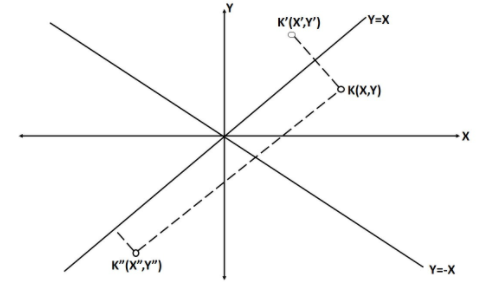
The image of P(a, b) on the line y = −x is Q and the image of Q on the line y = x is R. Then the midpoint of PQ is:
a. \[\left( {a + b,\;a + b} \right)\] b.$\left( {\dfrac{{a + b}}{2},\dfrac{{b + 2}}{2}} \right)$ c.$\left( {a - b,\;b - a} \right)$ d. (0, 0)
Answer
576.3k+ views
Hint: We will first find a general expression for the image of any point about $y = - x$ and $y = x.$ Then we will apply it to P and Q. Once this is done we will use the midpoint formula.
Complete step-by-step answer:

Consider any point K, its reflection about $y = x,$ K’ and its reflection about $y = - x,$ K” .
From the figure it is easy to draw the following conclusions:
K’ has its y and x interchanged from k, that is, K’(x’, y’) = K (y, x)
K” is analogous to K’ but has negative coordinate that is, K”(x”, y”) = K’(−x’, −y’) = K(−y, −x)
Using this, we can say that:
Coordinates of \[{\text{Q}} = \left( { - b, - a} \right)\] (reflect P along $y = - x$)
Coordinates of \[{\text{R}} = \left( { - a, - b} \right)\] (reflect Q along $y = - x$)
Coordinates interchange.
Now, the midpoint formula can be applied on P and R.
Let the midpoint be T.
x coordinate of ${\text{T}} = \dfrac{{{x_p} + {x_R}}}{2} = \dfrac{{a - a}}{2} = 0$
y coordinate of $T = \dfrac{{{y_p} + {y_R}}}{2} = \dfrac{{b - b}}{2} = 0$
Hence the midpoint is $\boxed{0,0.}$.
Option D is correct.
Note: Follow the following method to get the reflection of any point P(x,y) about line L: ax + by + c = 0.
1.Write the equation of a line with the slope perpendicular to L, ie,
N: bx - ay + d = 0.
2.Find out the value of d by substituting the value of P(x, y) in the equation.
3.Write the general coordinates of point Q(x’, y’) in terms of the equation N, ie, the coordinates would be (x’, (bx’-d)/a)
4.Now apply the condition that the perpendicular distance of Q from line L is equal to the perpendicular distance of P from line L. You can find the perpendicular distance of point P from L by the following formula :
$(ax + by + c)/\sqrt{(a^2 + b^2)}$, where x and y are the coordinates of P.
5.Find the value of x’ that satisfies the above condition.
6.Substitute the value of x’ in the coordinates in step 3 to find x’, y’ of the reflected point Q.
Complete step-by-step answer:

Consider any point K, its reflection about $y = x,$ K’ and its reflection about $y = - x,$ K” .
From the figure it is easy to draw the following conclusions:
K’ has its y and x interchanged from k, that is, K’(x’, y’) = K (y, x)
K” is analogous to K’ but has negative coordinate that is, K”(x”, y”) = K’(−x’, −y’) = K(−y, −x)
Using this, we can say that:
Coordinates of \[{\text{Q}} = \left( { - b, - a} \right)\] (reflect P along $y = - x$)
Coordinates of \[{\text{R}} = \left( { - a, - b} \right)\] (reflect Q along $y = - x$)
Coordinates interchange.
Now, the midpoint formula can be applied on P and R.
Let the midpoint be T.
x coordinate of ${\text{T}} = \dfrac{{{x_p} + {x_R}}}{2} = \dfrac{{a - a}}{2} = 0$
y coordinate of $T = \dfrac{{{y_p} + {y_R}}}{2} = \dfrac{{b - b}}{2} = 0$
Hence the midpoint is $\boxed{0,0.}$.
Option D is correct.
Note: Follow the following method to get the reflection of any point P(x,y) about line L: ax + by + c = 0.
1.Write the equation of a line with the slope perpendicular to L, ie,
N: bx - ay + d = 0.
2.Find out the value of d by substituting the value of P(x, y) in the equation.
3.Write the general coordinates of point Q(x’, y’) in terms of the equation N, ie, the coordinates would be (x’, (bx’-d)/a)
4.Now apply the condition that the perpendicular distance of Q from line L is equal to the perpendicular distance of P from line L. You can find the perpendicular distance of point P from L by the following formula :
$(ax + by + c)/\sqrt{(a^2 + b^2)}$, where x and y are the coordinates of P.
5.Find the value of x’ that satisfies the above condition.
6.Substitute the value of x’ in the coordinates in step 3 to find x’, y’ of the reflected point Q.
Recently Updated Pages
Why are manures considered better than fertilizers class 11 biology CBSE

Find the coordinates of the midpoint of the line segment class 11 maths CBSE

Distinguish between static friction limiting friction class 11 physics CBSE

The Chairman of the constituent Assembly was A Jawaharlal class 11 social science CBSE

The first National Commission on Labour NCL submitted class 11 social science CBSE

Number of all subshell of n + l 7 is A 4 B 5 C 6 D class 11 chemistry CBSE

Trending doubts
What is meant by exothermic and endothermic reactions class 11 chemistry CBSE

10 examples of friction in our daily life

One Metric ton is equal to kg A 10000 B 1000 C 100 class 11 physics CBSE

1 Quintal is equal to a 110 kg b 10 kg c 100kg d 1000 class 11 physics CBSE

Difference Between Prokaryotic Cells and Eukaryotic Cells

What are Quantum numbers Explain the quantum number class 11 chemistry CBSE




